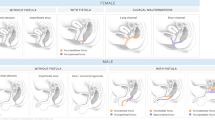Abstract
Background
Anorectal malformation is a spectrum of congenital defects of the distal bowel, mostly diagnosed at birth.
Objective
To describe the prenatal imaging findings of anorectal malformations, explore the causes of the low rates of prenatal diagnosis, compare the accuracy of prenatal ultrasound (US) and magnetic resonnance imaging [MRI] and evaluate the relevance of information obtained at MRI.
Materials and methods
Children treated for anorectal malformation at our hospital and with available prenatal studies were retrospectively identified and included in the study. We reviewed prenatal imaging exams, listed findings suggestive of the diagnosis, and compared results with the final classification.
Results
Fourteen fetuses and neonates — eight with intermediate–high type anorectal malformation and six with cloacae — fulfilled the inclusion criteria. All had associated congenital anomalies. Prenatal exams included 13 US and 8 MRI exams, with 7 children having both exams. Suggestive findings for anorectal malformation were detected in 50% of the cases prenatally and in 85% upon review. They were prospectively detected in 31% and 50% of the cases at US and MRI and retrospectively in 62% and 100% at US and MRI, respectively. MRI was superior to US because it improved the diagnosis, especially in cloacae, and provided relevant additional information that changed management in two cases.
Conclusion
The most important signs suggesting anorectal malformation are an absent target sign and anomalous distal bowel wall and rectal fluid. Complementary prenatal MRI improves the diagnosis of anorectal malformation.






Similar content being viewed by others
References
Levitt MA, Pena A (2007) Anorectal malformations. Orphanet J Rare Dis 2:33
Alamo L, Meyrat BJ, Meuwly JY et al (2013) Anorectal malformations: finding the pathway out of the labyrinth. Radiographics 33:491–512
Stoll C, Alembik Y, Dott B et al (2007) Associated malformations in patients with anorectal anomalies. Eur J Med Genet 50:281–290
Levitt MA, Pena A (2005) Outcomes from the correction of anorectal malformations. Curr Opin Pediatr 17:394–401
Lee MY, Won HS, Shim JY et al (2016) Sonographic determination of type in a fetal imperforate anus. J Ultrasound Med 35:1285–1291
Brantberg A, Blaas HGK, Haugen SE et al (2006) Imperforate anus: a relatively common anomaly rarely diagnosed prenatally. Ultrasound Obstet Gynecol 28:904–910
Bischoff A, Levitt MA, Lim FY et al (2010) Prenatal diagnosis of cloacal malformations. Pediatr Surg Int 26:1071–1075
Perlman S, Bilik R, Leibovitch L et al (2014) More than a gut feeling — sonographic prenatal diagnosis of imperforate anus in a high-risk population. Prenat Diagn 34:1307–1311
Vijayaraghavan SB, Prema AS, Suganyadevi P (2011) Sonographic depiction of the fetal anus and its utility in the diagnosis of anorectal malformations. J Ultrasound Med 30:37–45
Ochoa JH, Chiesa M, Vildoza RP et al (2012) Evaluation of the perineal muscular complex in the prenatal diagnosis of anorectal atresia in a high-risk population. Ultrasound Obstet Gynecol 39:521–527
Su YM, Lin Y, Chen SQ et al (2018) Prenatal evaluation for detection of anorectal atresia: value of ultrasound. J Ultrasound Med 38:1501–1509
Mallmann MR, Reutter H, Gottschalk I et al (2019) Prenatal diagnosis of enterolithiasis in 20 cases. Fetal Diagn Ther 15:1–8
Livingston JC, Elicevik M, Breech L et al (2012) Persistent cloaca, a 10-year review of prenatal diagnosis. J Ultasound Med 31:403–407
Bach-Segura P, Droullé P (2008) Fetal digestive tract imaging. Gynecol Obstet Fertil 36:950–968
Veyrac C, Couture A, Saguintaah BC Baud C (2004) MRI of fœtal GI tract abnormalities. Abdom Imaging 29:411–420
Capito C, Belarbi N, Paye Jaouen A et al (2014) Prenatal pelvic MRI: additional clues for assessment of urogenital obstructive anomalies. J Pediatr Urol 10:162–166
Peiro JL, Scorletti F, Sbragia L (2016) Prenatal diagnosis of cloacal malformation. Semin Pediatr Surg 25:71–75
Calvo-Garcia MA, Kline-Fath BM, Levitt MA et al (2011) Fetal MRI clues to diagnose cloacal malformations. Pediatr Radiol 41:1117–1128
Winkler NS, Kennedy AM, Woodward PJ (2012) Cloacal malformation: embryology, anatomy and prenatal imaging features. J Ultrasound Med 31:1843–1855
Dannull K, Sung J (2014) Cloacal dysgenesis diagnosis by prenatal ultrasound and MRI. Pediatr Radiol 44:230–233
Bronshtein M, Gover A, Beloosesky R et al (2017) Transient distension of right posterior located sigma, a new sonographic sign for the prenatal diagnosis of anal atresia. J Clin Ultrasound 45:160–162
Warne S, Chitty LS, Wilcox DT (2002) Prenatal diagnosis of cloacal anomalies. BJU Int 89:78–81
Mallmann MR, Reutter H, Mack-Detlefsen B et al (2019) Prenatal diagnosis of hydro(metro)colpos: a series of 20 cases. Fetal Diagn Ther 45:62–68
Swiss Society for Ultrasound in Medicine, Obstetrical and Gynecology section (2011) Recommandations pour les examens échographiques en cours de grossesse, 3ème version [Recommendations for prenatal ultrasound assessment]. Bern, Switzerland
Holschneider A, Hutson J, Pena A et al (2005) Preliminary report on the international conference for the development of standards for the treatment of anorectal malformations. J Pediatr Surg 40:1521–1526
Moon MH, Cho JY, Kim JH et al (2010) In-utero development of the fetal anal sphincter. Ultrasound Obstet Gynecol 35:556–559
Author information
Authors and Affiliations
Corresponding author
Ethics declarations
Conflicts of interest
None
Additional information
Publisher’s note
Springer Nature remains neutral with regard to jurisdictional claims in published maps and institutional affiliations.
Rights and permissions
About this article
Cite this article
Rohrer, L., Vial, Y., Gengler, C. et al. Prenatal imaging of anorectal malformations — 10-year experience at a tertiary center in Switzerland. Pediatr Radiol 50, 57–67 (2020). https://doi.org/10.1007/s00247-019-04513-2
Received:
Revised:
Accepted:
Published:
Issue Date:
DOI: https://doi.org/10.1007/s00247-019-04513-2




